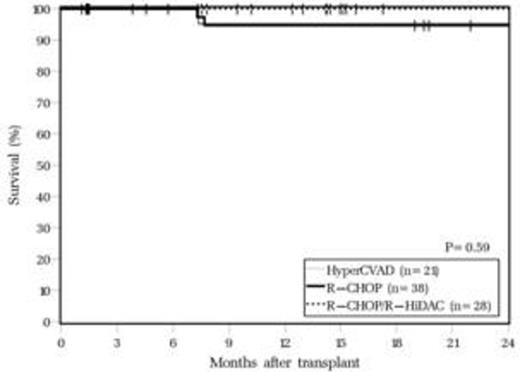Abstract
Introduction: A common approach to initial treatment for young, fit patients (pts) with mantle cell lymphoma (MCL) is induction chemoimmunotherapy followed by high dose chemotherapy with autologous stem cell support (ASCT). Induction regimens with modifications of R-CHOP (rituximab-cyclophosphamide-doxorubicin-vincristine-prednisone) and/or incorporation of high dose cytarabine (HiDAC) appear more effective than RCHOP alone, as in R-HyperCVAD/MA (cyclophosphamide-vincristine-doxorubicin-dexamethasone alternating with methotrexate-cytarabine, MDACC), R-CHOP alternating with R-DHAP (rituximab-dexamethasone-cytarabine-cisplatin, European MCL Network) and dose intensified R-CHOP alternating with HiDAC followed by ASCT (Nordic Lymphoma Group). At the Cleveland Clinic, in 2010 we adopted as our standard induction regimen a modification of the Nordic protocol, using standard dose R-CHOP alternating with R-HiDAC for 3 cycles each or, for pts who had already been treated with R-CHOP x 6 cycles prior to referral for ASCT, an additional 2 R-HiDAC. Here we report analysis of our institutional experience with this regimen. We use as historical comparison pts with MCL who underwent ASCT at our institution following R-HyperCVAD/MA or R-CHOP.
Method: We retrospectively analyzed the outcome of 87 MCL pts who received first line therapy including ASCT at Cleveland Clinic from Aug 1999 - Apr 2014. Pt characteristics, treatment regimens and biological markers were evaluated with regard to overall survival (OS) and relapse free survival (RFS). Pts were grouped according to induction chemotherapy: Group A (HyperCVAD/MA x4 cycles), Group B (R-CHOP x 6 cycles), and Group C (R-CHOP alternating with R-HiDAC for 6 total cycles or R-CHOP x 6 cycles followed by HiDAC x 2 cycles). All pts received ASCT consolidation therapy with high dose busulfan, cyclophosphamide, and etoposide. OS and RFS were estimated using the Kaplan-Meier method and compared among groups using the log-rank test. Cox proportional hazards analysis was used to identify univariable prognostic factors for OS and RFS.
Results: The median age of the entire cohort was 59 years (range: 41-73), with male predominance (74%). All pts had ECOG performance score ≤1, MIPI low/intermediate/high scores were 57%/30%/13%. Complete remission prior to ASCT was achieved in 76% of pts. Pt characteristics, including MIPI scores, were evenly distributed among three treatment groups except for: (1) age (median age at diagnosis Group A=53 yr, Group B=62 yr, and Group C=57 yr, P<0.001) (2) more blastoid subtype in Group A (19%) while Group C had no blastoid subtypes of MCL (0%, P=0.03); and (3) higher proportion of patients in Group C with comorbidities (85.7%, p=0.003).
With a median follow-up of 26.6 months, 2 year OS rate (Fig. 1) was 95.2%, 94.7% and 100% in groups A, B and C respectively; 2 year RFS rate (Fig. 2) of 85.7%, 73.7% and 93.3% respectively. In univariate analysis, blastoid subtype (HR=5.37, 95% CI 1.97-14.6), and high risk MIPI score (HR=14, 95% CI 3.38-57.6) were predictive of OS as well as of RFS (HR = 2.76, 95% 1.14-6.69 and HR 6.45, 95% CI 2.41-17.2). Post-ASCT treatment was required for 41% of pts, 8 pts (42.1%) in group A, 38 pts (58.3%) in group B and 5 pts (17.9%) in group C, although pts in group C had shortest follow up to date.
In conclusion, our outcomes for pts with newly diagnosed MCL demonstrated no statistically significant difference in OS and RFS among the 3 treatment groups. While longer followup is needed, these data suggest that our less toxic approach of using standard dose and schedule R-CHOP alternating with R-HiDAC, without dose-intense R-CHOP or addition of methotrexate or cisplatin, is highly effective pre-ASCT first line therapy for MCL.
No relevant conflicts of interest to declare.
Author notes
Asterisk with author names denotes non-ASH members.



This feature is available to Subscribers Only
Sign In or Create an Account Close Modal